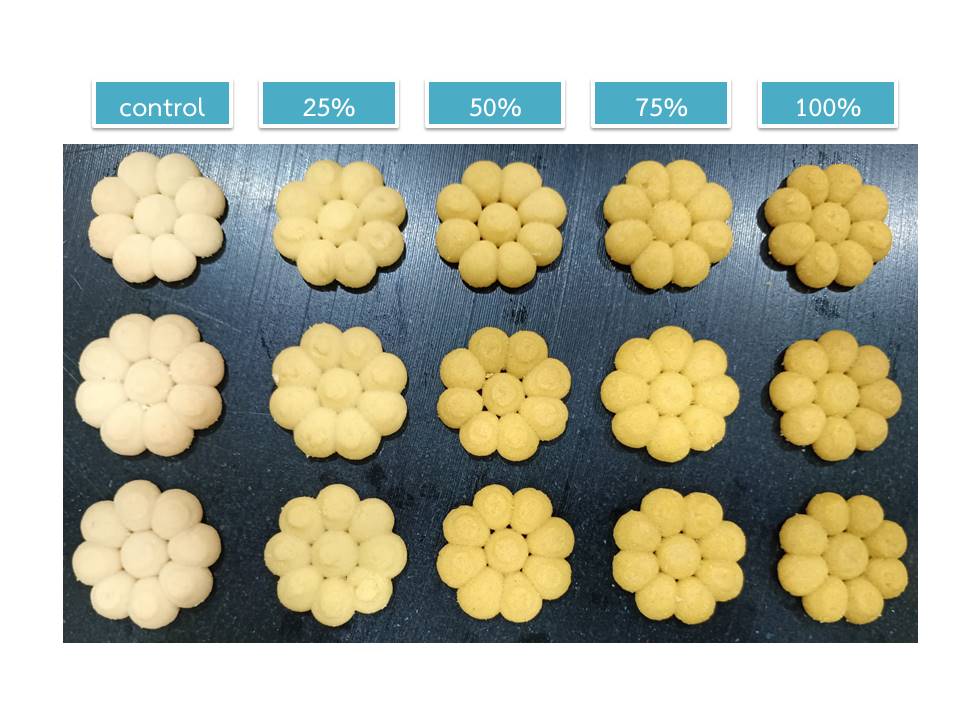ผลของการทดแทนแป้งสาลีด้วยผงกากข้าวโพดหวานต่อคุณภาพของคุกกี้
คำสำคัญ:
ผงกากข้าวโพดหวาน , การทดแทนแป้งสาลี , คุกกี้ , การประเมินทางประสาทสัมผัสบทคัดย่อ
วัตถุประสงค์และที่มา : ผลิตภัณฑ์น้ำนมข้าวโพดหวานของศูนย์วิจัยข้าวโพดและข้าวฟ่างถือได้ว่าเป็นผลิตภัณฑ์ที่ได้รับความนิยมในทุกเพศทุกวัย เนื่องจากมีกลิ่นหอมที่เป็นเอกลักษณ์และรสชาติที่ถูกปาก ส่งผลให้ปริมาณการผลิตน้ำนมข้าวโพดออกสู่ตลาดมีปริมาณมากและทำให้มีกากข้าวโพดซึ่งเป็นผลพลอยได้จากกระบวนการผลิตมีปริมาณมากตามไปด้วย โดยส่วนใหญ่ผู้ผลิตจะนำกากข้าวโพดไปขายเพื่อผลิตเป็นอาหารสัตว์ประมาณ 900–1,000 กิโลกรัมต่อวัน ดังนั้นเพื่อเพิ่มมูลค่าวัตถุดิบเหลือใช้จากกระบวนการแปรรูปผลผลิตทางการเกษตรและลดปริมาณการใช้แป้งสาลี อีกทั้งยังทำให้ผลิตภัณฑ์ที่พัฒนาได้มีคุณค่าอาหารเพิ่มขึ้น งานวิจัยนี้มีวัตถุประสงค์เพื่อศึกษาปริมาณที่เหมาะสมในการนำกากข้าวโพดหวานมาใช้ประโยชน์โดยการทดแทนแป้งสาลีในคุกกี้เพื่อหาปริมาณที่เหมาะสมที่ผู้บริโภคยอมรับดีที่สุด
วิธีดำเนินการวิจัย : ทำการเตรียมผงกากข้าวโพดหวานโดยนำกากสดข้าวโพดหวานอบแห้งที่อุณหภูมิ 70 องศาเซลเซียส นาน 24 ชั่วโมง บดละเอียดจะได้แป้งที่มีลักษณะเป็นผงมีสีเหลืองละเอียด และทำการวิเคราะห์คุณภาพทางเคมีกายภาพ ได้แก่ ค่าสี ปริมาณสารเบต้าแคโรทีน ปริมาณสารฟีนอลิกทั้งหมดและฤทธิ์การต้านอนุมูลอิสระด้วยวิธี DPPH และ ABTS free radical scavenging assay ก่อนนำผงกากข้าวโพดหวานไปทดแทนการใช้แป้งสาลีในคุกกี้ ทำการคัดเลือกสูตรพื้นฐานสำหรับการผลิตคุกกี้ โดยใช้สูตรของคุกกี้ที่แตกต่างกัน 5 สูตร ด้วยวิธีประเมินคุณลักษณะทางประสาทสัมผัสกับผู้ทดสอบชิมทั่วไปจำนวน 50 คน สูตรพื้นฐานที่ผู้ทดสอบชิมให้คะแนนความชอบโดยรวมมากที่สุดจะถูกนำมาทำการพัฒนาสูตรคุกกี้ที่มีการทดแทนแป้งสาลีด้วยผงกากข้าวโพดหวาน โดยศึกษาการทดแทนการใช้แป้งสาลีด้วยผงกากข้าวโพดหวานในคุกกี้ที่ปริมาณร้อยละ 0, 25, 50, 75 และ 100 (โดยน้ำหนักแป้ง) นำตัวอย่างคุกกี้ไปตรวจสอบลักษณะทางด้านกายภาพ เคมี ได้แก่ ความกว้าง ความหนา อัตราการแผ่ขยายตัว ค่าความแข็ง ค่าสี ปริมาณน้ำอิสระ องค์ประกอบทางเคมี (ความชื้น โปรตีน ไขมัน เถ้า คาร์โบไฮเดรต และใยอาหาร) ปริมาณสารเบต้าแคโรทีน ปริมาณสารฟีนอลิกทั้งหมดและฤทธิ์การต้านอนุมูลอิสระด้วยวิธี DPPH และ ABTS และทดสอบการยอมรับทางประสาทสัมผัสด้านการยอมรับโดยรวม ลักษณะปรากฏ สี รสชาติ เนื้อสัมผัส และกลิ่นรส
ผลการวิจัย : ผงกากข้าวโพดหวานที่ผ่านการอบแห้งและบดละเอียด พบว่ามีค่าความสว่าง (L*)ความเป็นสีแดง (a*) ความเป็นสีเหลือง (b*) คือ 77.39, 7.68 และ 37.83 ตามลำดับ สำหรับค่าความสดของสี (C*) คือ 38.60 ส่วนค่ามุมมองของโทนสี (h°) คือ 78.51 อยู่ในช่วงความเป็นสีส้มแดงถึงเหลือง และความแตกต่างของสี (E) คือ 16.30 นอกจากนั้นแล้วยังมีสารเบต้าแคโรทีน 350.52 ไมโครกรัมต่อ 100 กรัม มีปริมาณสารฟีนอลิกทั้งหมด 55.36 มิลลิกรัมสมมูลของกรดแกลลิกต่อ 100 กรัม ค่ากิจกรรมการต้านอนุมูลอิสระด้วยวิธี DPPH และ ABTS 94.48 และ 44.72 มิลลิกรัมสมมูลของโทรลอกซ์ต่อ 100 กรัม ตามลำดับสำหรับผลการคัดเลือกคุกกี้สูตรพื้นฐานพบว่า คุกกี้สูตรพื้นฐานสูตรที่ 4 มีค่าคะแนนความชอบต่อคุณลักษณะทางประสาทสัมผัสสูงกว่าสูตรอื่นๆ โดยมีส่วนประกอบหลัก คือ แป้งสาลีอเนกประสงค์ น้ำตาล เนยเค็ม ไข่ไก่ ผงฟู เบกกิ้งโซดา ร้อยละ 27.18, 27.18, 36.35, 8.95, 0.23 และ 0.11 ตามลำดับ ดังนั้นคุกกี้สูตรพื้นฐานที่ 4 จึงถูกเลือกไปศึกษาระดับการทดแทนแป้งสาลีด้วยผงกากข้าวโพดหวาน พบว่าการเติมผงกากข้าวโพดหวานลงในคุกกี้ไม่มีผลต่อค่าความกว้าง ความหนา และอัตราการแผ่ขยายตัว (p>0.05) ยกเว้นค่าความแข็งและปริมาณน้ำอิสระในอาหารที่เพิ่มขึ้นตามระดับการทดแทน (p≤0.05) นอกจากนั้นแล้วคุกกี้ที่ได้ยังมีค่าความสว่างลดลง ส่วนค่าความเป็นสีแดงและค่าความเป็นสีเหลืองเพิ่มขึ้น (p£0.05) สำหรับค่าความสดของสี (C*) และความแตกต่างของสี (
E) เพิ่มขึ้นขณะที่ค่ามุมมองของสี (h°) ลดตามระดับการทดแทนด้วยผงกากข้าวโพด โดยอยู่ในช่วง 63.92–75.36 แสดงถึงสีอยู่ในช่วงสีส้มแดงถึงสีเหลือง สำหรับผลการวิเคราะห์องค์ประกอบทางเคมีของคุกกี้พบว่ามีการเพิ่มขึ้นของปริมาณความชื้น (ร้อยละ 2.00–3.39) โปรตีน (5.95–8.60) ไขมัน (ร้อยละ 28.67–32.22) เถ้า (ร้อยละ 1.08–2.01) และใยอาหาร (ร้อยละ 1.14–8.64) ขณะที่ปริมาณคาร์โบไฮเดรตลดลง คือ ร้อยละ 63.32–53.79 ตามระดับของผงกากข้าวโพดหวานที่เพิ่มขึ้น (p£0.05) นอกจากนั้นแล้วคุกกี้ที่ได้ยังมีปริมาณสารเบต้าแคโรทีน สารปริมาณสารฟีนอลิกทั้งหมด และมีฤทธิ์การต้านอนุมูลอิสระเมื่อวิเคราะห์ด้วยวิธี DPPH และ ABTS เพิ่มขึ้นอย่างมีนัยสำคัญอีกด้วย (p£0.05) จากการทดสอบทางประสาทสัมผัสพบว่าตัวอย่างที่เติมผงกากข้าวโพดร้อยละ 25 ได้รับคะแนนความชอบโดยรวมไม่แตกต่างจากตัวอย่างควบคุม (p>0.05)
สรุปผลการวิจัย : อัตราส่วนที่เหมาะสมของการใช้ผงกากข้าวโพดหวานแทนแป้งสาลี คือ ร้อยละ 25 เนื่องจากได้รับคะแนนความชอบโดยรวมไม่แตกต่างจากตัวอย่างควบคุม (p>0.05) คุกกี้ที่ได้มีค่าความสว่าง 57.28 ความเป็นสีแดง 6.51 ความเป็นสีเหลือง 18.04 ค่าความสดของสี 21.88 และมุมมองของสี 71.93 (สีส้มแดงถึงสีเหลือง) มีองค์ประกอบทางเคมี ได้แก่ ปริมาณความชื้น โปรตีน ไขมัน เถ้า คาร์โบไฮเดรต และใยอาหาร ร้อยละ 2.47, 6.77, 29.58, 1.27, 59.92 และ 2.28 ตามลำดับ มีปริมาณสารเบต้าแคโรทีน ปริมาณสารฟีนอลิกทั้งหมด เท่ากับ 55.59 ไมโครกรัมต่อ 100 กรัม และ 98.62 มิลลิกรัมสมมูลของกรดแกลลิกต่อ 100 กรัม ตามลำดับ และมีฤทธิ์การต้านอนุมูลอิสระเมื่อวิเคราะห์ด้วยวิธี DPPH และ ABTS เท่ากับ 12.59 และ 35.16 มิลลิกรัมสมมูลโทรลอกซ์ต่อ 100 กรัม ตามลำดับสรุปได้ว่าการใช้ผงกากข้าวโพดหวานมีศักยภาพในการเพิ่มคุณค่าโภชนาการและสารต้านอนุมูลอิสระของคุกกี้
เอกสารอ้างอิง
AACC. (2000). Approved methods of the American Association of Cereal Chemists. (8th ed.), Minnesota: The American Association of Cereal Chemists Inc.
Adebowale, A.A., Adegoke, M.T., Sanni, S.A., Adegunwa, M.O., & Fetuga, G.O. (2012). Functional properties and biscuit making potentials of sorghum–wheat flour composite. American Journal of Food Technology, 7(6), 372–379.
Akther, S., Jothi, J.S., Badsha, M.R., Rahman, M.M., Das, G.B., & Alim, A.A. (2023). Drying methods effect on bioactive compounds, phenolic profile, and antioxidant capacity of mango powder. Journal of King Saud University, 35(1), 1–11.
Al–Saab, A.H., & Gadallah, M.G.E. (2021). Phytochemicals, antioxidant activity and quality properties of fibre enriched cookies incorporated with orange peel powder. Food Research, 5(4), 72–79.
AOAC. (2019). Official Methods of Analysis of AOAC International. (21th ed.). Washington DC.: The Association of Official Analytical Chemists Inc.
Ayo, J. A., Ayo, V. A., Nkama, I., & Adeworie, R. (2007). Physiochemical, invitro digestibility and organoleptic
evaluation of acha–wheat biscuit supplemented with soybean flour. Nigerian Food Journal, 25(1), 77–89.
Baljeet, S. Y., Ritika, B. Y. , & Reena, K. (2014). Effect of incorporation of carrot pomace powder and germinated chickpea flour on the quality characteristics of biscuits. International Food Research Journal, 21(1), 217–222.
Beuchat, L. (1981). Microbial stability as affected by water activity. Cereal Foods World, 26, 345–349.
Bogacz-Radomska, L., & Harasym, J. (2018). β-Carotene–properties and production methods. Food Quality and Safety, 2(2), 1–6.
Brand–Williams, W., Cuvelier, M. E., & Berset, C. (1995). Use of a free radical method to evaluate antioxidant activity. LWT–Food Science and Technology, 28(1), 25–30.
Dangsungwal, N., Siriwong, N., & Riebroy, S. (2011). Use of banana flour substituted for wheat flour in brownie. In Proceeding of the 49th Kasetsart University Annual Conference. (pp. 66-73). Bangkok. (in Thai)
Elleuch, M., Bedigian, D., Roiseux, O., Besbes, S., Blecker, C., & Atta, H. (2011). Dietary fibre and fibre-rich by-products offood processing: Characterization, technological functionality and commercial applications : A review. Food Chemistry, 124, 411–421.
Ho, L.H., & Abdul Latif, N.W. (2016). Nutritional composition, physical properties, and sensory evaluation of cookies prepared from wheat flour and pitaya (Hylocereus undatus) peel flour blends. Cogent Food and Agriculture, 2(1), 1–10.
Ihekoronye, A.I. ,& Ngoddy, P.O. (1985). Integrated Food Science and Technology for the Tropics. (pp. 306) London : Macmillan.
Ikuomola, D.S. , Otutu, O.L., & Oluniran, D.D. (2017). Quality assessment of cookies produced from wheat flour and malted barley (Hordeum vulgare) bran blends. Cogent Food & Agriculture, 3(1), 1–12.
İncedayı, B., Tamer, C. E., Sınır, G.Ö. Suna, S., & Çopur, Ö.U. (2016). Impact of different drying parameters on color, beta-carotene, antioxidant activity and minerals of apricot (Prunus armeniaca L.). Food Science and Technology, 36(1), 171–178.
Jiamyangyuen, S. (2003). Sensory evaluation in food. Phitsanulok: Naresuan University. (in Thai)
Kausar, T., Saeed, E., Hussain, A., Firdous, N., Bibi, B., Kabir, K., An, Q.U., Ali, M.Q., Najam, A., Ahmed, A. Yaqub, S., & Elkhedir, A.E. (2024). Development and quality evaluation of cookies enriched with various levels of grapefruit pomace powder. Discover Food, 65(4), 1–12.
KhumKhom, S. (2018). Effect of additional dried sesbania (Sesbania javanica Miq.) flowers powder on physical, nutritional and organoleptic characteristics of butter cookies. Phranakhon Rajabhat Research Journal (Science and Technology), 13(1),139–154. (in Thai)
Krinsky, N.I. (1994). The Biological Properties of Carotenoids. Pure and Applied Chemistry, 66(5), 1003–1010.
Kulkarni, S.S., Desai, A.D., Ranveer R.C. & Sahoo, A.K. (2012). Development of nutrient rich noodles by supplementation with malted ragi flour. International Food Research Journal, 19(1), 309-313.
Kurniasari, H., David, W., Cempaka, L & Ardiansyah, A. (2022). Effects of drying techniques on bioactivity of ginger (Zingiber officinale): A meta-analysis investigation. Agriculture and Food, 7(2), 197–211.
Lao, Y. X., Yu, Y. Y., Li, G. K., Chen, S. Y., Li, W., Xing, X. P., Wang, X. M., Hu, J. G., & Guo, X. B. (2019). Effect of sweet corn residue on micronutrient fortification in baked cakes. Foods, 8(7), 1-13.
Lattimer, J.M., & M.D. Haub. (2010). Effects of dietary fiber and its components on metabolic health. Nutrients, 2, 1266–1289.
Li, Y., Hong, Y., Han, Y., Wang, Y., & Xia, L. (2016). Chemical characterization and antioxidant activities comparison in fresh, dried, stir-frying and carbonized ginger. Journal of Chromatography B, 1011, 223–232.
McGuire, R. G. (1992). Reporting of objective color measurements. HortScience, 27(12), 1254-1255.
Meechai, P. 2017. Count 1 to 10 gets rich from the bakery. Bangkok: Book Maker. (in Thai)
Milani, A., Basirnejad, S., Shahbazi, S., & Bolhassani, A. (2017). Carotenoids: biochemistry, pharmacology and treatment. British Journal of Pharmacology, 174(11), 1290–1324.
Mrabet, A., Rodriguez-Gutierrez, G., Rodriguez-Arcos, R., Guillen-Bejarano, R., Ferchichi, A., Sindic, M., & Jimenez-Araujo, A. (2016). Quality characteristics and antioxidant properties of muffins enriched with date fruit (Phoenix dactylifera L.) fiber concentrates. Journal Food Quality, 39(4), 237–44.
Mudgil, D., Barak, S., & Khatkar, B.S. (2017). Cookie texture, spread ratio and sensory acceptability of cookies as a function of soluble dietary fiber, baking time and different water levels. LWT–Food Science and Technology, 80, 537–542.
Nagata, M., & Yamashita, I. (1992). Simple method for simultaneous determination of chlorophyll and carotenoids in tomato fruit. Nippon Shokuhin Kogyo Gakkaish, 39(10), 925–928.
Ndife, J., Kida, F., & Fagbemi, S. (2014).Production and quality assessment of enriched cookies from whole wheat and full fat soya. European Journal of Food Science and Technology, 2(2), 19–29.
Nguyen, T.Q.N., Nguyen, P.H., Vo, M.T., & Le, V.V.M. (2024). Utilizing sweet corn “milk” residue to develop fiber-rich pasta: effects of replacement ratio and transglutaminase treatment on pasta quality. Journal of Food Processing and Preservation, 2024(1), 1–9.
Noiduang, P., & Nakhon, B. (2015). Utilization of maltitol and sucralose in low–calories butter cookies production. APHEIT Journal, 21(2), 42–51. (in Thai)
Oboh, G., & Adefegha, S.A. (2010). Inhibitory properties of phenolic enriched in wheat biscuits on Fe2+ induced Lipid peroxidation in Rat’s brain in vitro. Advances in Food Sciences, 32(3), 162-169.
Omueti, O., & Ajomale, K. (2005). Chemical and sensory attributes of soy-corn milk types. African Journal of Biotechnology, 4(9), 847-851.
Poonnakasem, N. (2016). Development of butter cookie with fiber from pomelo albedo. SDU Research Journal Science and Technology, 9(1), 35–49. (in Thai)
Premprasopchok, T., Jankao, S., & Tanoi1, Pr. (2015). Substitution of sugar with banana (Musa sapientum Linn.) for cookies production. In Proceeding The 53th Kasetsart University Annual Conference. (pp. 923–930). Bangkok. (in Thai).
Promthep, N. (2020). Study of antioxidant and developement of sterilized concentrated corn milk products. Master Thesis, Mahasarakham University, Mahasarakham. (in Thai).
Re, R., Pellegrini, N., Proteggente, A., Pannala, A., Yanh, M., & Rice-Evans, C. (1999). Antioxidant activity applying an improved ABTS radical cation decolorization assay. Free Radical Biology and Medicine, 26(9–10), 1231–1237.
Sahni, P., & Shere, D.M. (2017). Physico-chemical and sensory characteristics of carrot pomace powder incorporated fibre rich cookies. Asian Journal of Dairy and Food Research, 36(4), 327–331.
Sanni, S.A., Adebowale, A.A., Olayiwola, I. O., & Maziya–Dixon, B. (2008). Chemical composition and pasting properties of iron fortified maize flour. Journal of Food, Agriculture and Environment, 6(3&4), 172–175.
Scott, C. E., & Eldridge, A. L. (2005). Comparison of carotenoid content in fresh. Journal of Food Composition and Analysis, 18(6), 551–559.
Sinay, H., & Harijati, N. (2021). Determination of proximate composition of local corn cultivar from Kisar Island, Southwest Maluku Regency. Journal of Biology & Biology Education, 13(3), 258–266.
Slavin, J.L. (2005). Dietary fiber and body weight. Nutrition, 21(3), 411–418.
Sopa, B., Fudsiri, S., & Jankuen, S. (2021). Utilization of dried sweet corn cake powder for wheat flour replacement in brownies. Agricultural Science, 52(1)(Suppl.), 61–64. (in Thai)
Sopa, B., S. Fudsiri, S. Jankuen , C. Jitlaka, K, Kanyakam , & J. Kongphapa. (2022). Effect of sweet corn varieties on quality of boiled sweet corn and corn milk products. Agricultural Science Journal, 53(3), 226–241. (in Thai)
Tarwaca, S.N., Karyadi, J.N.W., Nugraheni, N.F., Indrasari, Y.P., Albyan, R., Setiyadi, I., & Ayuni, D. (2021). Effect of various drying methods on the physicochemical characteristics of pumpkin powder. In IOP Conference Series: Earth and Environmental Science. (pp. 1–6). Montréal: Canada.
Thai Industrial Standards Institute. (2012). Thai Community Product standard (TCPS 118/2012): Cookies. Ministry of Industry, Bangkok, Thailand. (in Thai)
Thepyothin, W., Senawong, N., & Muang Phrom, J. (2021). The Quality and consumer acceptance of corn milk powder with sugar coating and pasteurized process. In Proceeding The 5th Rajamangala University of Technology National Conference. (pp. 192-202). Bangkok. (in Thai)
Tinchan, P., Dechkunchorn, M., & Kaewka, K. (2019). Effect of corn milk by-product addition on the physical properties of whole wheat bread. Chiang Mai University Journal of Natural Sciences, 18(1), 94–106.
Usman, M., Ahmed, S., Mehmood, A., Bilal, M., Patil, P.J., Akram, K., & Farooq, U. (2020). Efect of apple pomace on nutrition, rheology of dough and cookies quality. Journal of Food Science and Technology, 57(9), 3244–3251.
Wangpankhajorn, P., Maneechot, S., Junsi, M., Jannu. T., & R. Sukeaw Samakradhamrongthai. (2020). Effect of substitution of wheat flour with Sungyod rice flour on physical and sensory qualities in cookies. Journal of Science and Technology, 9(2), 63–70. (in Thai)
Wrivutthikorn, W. (2024). Development of Crispy Roti Flour Using Riceberry Flour as Substitute for All Purpose Wheat Flour . Burapha Science Journal, 29(1), 160–180. retrieved from https://li05.tci-thaijo.org/index.php/buuscij/article/view/213
Yingngam, B., Monschein, M., & Brantner, A. (2014). Ultrasound-assisted extraction of phenolic compounds from Cratoxylum formosum ssp. formosum leaves using central composite design and evaluation of its protective ability against H2O2–induced cell death. Asian Pacific Journal of Tropical Medicine, 7(1)(Suppl.), S497–S505.
Zhang, B., Quan, H., Cai, Y., Han. X., Kang, H., Lu, Y., Cheng, H., Xiang, N., Lan, X., & Guo, X. (2023). Comparative study of browning, phenolic profiles, antioxidant and antiproliferative activities in hot air and vacuum drying of lily (Lilium lancifolium Thunb.) bulbs. LWT–Food Science and Technology, 184, 1–13.

ดาวน์โหลด
เผยแพร่แล้ว
รูปแบบการอ้างอิง
ฉบับ
ประเภทบทความ
สัญญาอนุญาต
ลิขสิทธิ์ (c) 2025 คณะวิทยาศาสตร์ มหาวิทยาลัยบูรพา

อนุญาตภายใต้เงื่อนไข Creative Commons Attribution-NonCommercial-NoDerivatives 4.0 International License.
Burapha Science Journal is licensed under a Creative Commons Attribution-NonCommercial-NoDerivatives 4.0 International (CC BY-NC-ND 4.0) licence, unless otherwise stated. Please read our Policies page for more information



